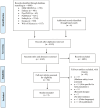Deconstruction of farm machine-related safety interventions: a systematic review and narrative synthesis
- PMID: 39801357
- PMCID: PMC11911511
- DOI: 10.1093/annweh/wxae105
Deconstruction of farm machine-related safety interventions: a systematic review and narrative synthesis
Abstract
Introduction: Agricultural workplaces have a high number of incidents and fatalities, with the majority occurring from machinery use. Farmers' behaviour plays a critical role in maintaining safety, as improper or unsafe practices often lead to injuries and fatalities. This review categorises interventions targeting farm machine safety, examining both the behaviour change techniques (BCTs) used and their reported outcomes to understand how the techniques influence safety practices and outcomes on farms.
Methods: The systematic review is reported in accordance with the Preferred reporting items for systematic reviews and meta-analysis guidelines. Seven electronic databases were searched for relevant studies published before June 2024, and the quality of included studies was assessed using Cochrane risk of bias assessment tools. Analysis of intervention behavioural components was guided by the behaviour change wheel framework and BCT taxonomy (v1). The findings were synthesised using a narrative review.
Results: Nine studies were included and a total of 21 BCTs were identified. The most frequently coded BCTs were 4.1 (instruction on how to perform the behaviour), 10.8 (incentive [outcome]), and 16.3 (vicarious consequences) (each n = 6). Reported outcomes included reductions in injury rates, improved adoption of safety devices, implementation of safety measures, and positive shifts in safety norms and perceptions. However, due to variations in intervention design and reporting, assessing the direct impact of specific BCTs on these outcomes proved challenging.
Discussion: The use of BCT taxonomy provided a common language for describing intervention components and enabled the standardisation of intervention content analysis. While patterns were observed regarding the commonly used BCTs, their implementation and outcomes, the heterogeneity and limited details provided by studies limited our ability to discern their effectiveness. Providing (i) greater transparency in reporting active intervention components and (ii) clearer connections between components and specific outcomes, will enable enhanced comparisons of future studies, and facilitate a greater understanding of how to support safe machine-related behaviours on farms.
Keywords: BCT; behaviour change interventions; farm injuries; farm safety; occupational safety; tractor rollover; tractor safety.
© The Author(s) 2025. Published by Oxford University Press on behalf of the British Occupational Hygiene Society.
Conflict of interest statement
None decclared.
Figures
References
-
- Andarge T, Lichtenberg E.. 2020. Regulatory compliance under enforcement gaps. J Regul Econ. 57(3):181–202. https://doi.org/10.1007/s11149-020-09405-0 - DOI
-
- Angioloni S, Jack C.. 2022. Farm fatalities in Northern Ireland agriculture: what fifty years of data tell us. Econ Hum Biol. 46:101122. https://doi.org/10.1016/j.ehb.2022.101122 - DOI - PubMed
-
- Bunker A, Bärnighausen T, Woodward A, Bullen C. 2020. Housing structure and occupant behaviour to increase the environmental and health co-benefits of housing: Insights from expert interviews in New Zealand. Indoor and Built Environment 30(4):535–553. https://doi.org/10.1177/1420326X19897965. - DOI
-
- Burrow AJ. 2017. A look at behavior-based safety program effectiveness: a qualitative study of participants’ perceptions of safety program effectiveness in a Bayer CropScience’s Cottonseed Delinting Plant (Doctoral dissertation). Texas Tech University.
-
- Byard RW. 2017. Farming deaths – an ongoing problem. Forensic Science, Medicine, and Pathology 13(1):1–3. https://doi.org/10.1007/s12024-017-9839-8. - DOI - PubMed
Publication types
MeSH terms
Grants and funding
LinkOut - more resources
Full Text Sources
Medical




